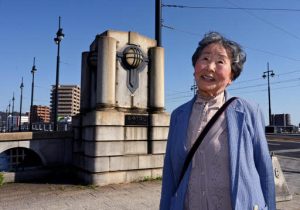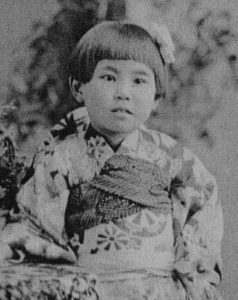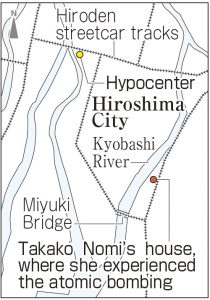Survivors’ stories: Takako Nomi, 86, Higashi Ward, Hiroshima
May 7, 2020
by Kyoko Niiyama, Staff Writer
Takako Nomi (nee Ishimoto), 86, cannot forget what she saw at Miyuki Bridge after the atomic bombing. There, 2.3 kilometers from the hypocenter, she witnessed people with severe burns wandering in agony. The riverbanks were filled with people who might or might not have been alive.
In 1945, Ms. Nomi was 11 and a sixth grader at Minami National School (now Minami Elementary School, located in Minami Ward, Hiroshima). She lived in Minami-machi 1-chome with her parents and two younger brothers. One of her brothers was 21 months old and the other was 4. They liked her very much, and she took good care of them. Her father, Masao, was always busy producing military supplies at an iron foundry he operated next to their house.
Ms. Nomi evacuated with other school children to what is now Asaminami Ward for their safety, but moved back home in July because her health had deteriorated. On the night of August 5, her mother Chiyono said to her, “Don’t go to school tomorrow and take care of your brothers. I have to do some volunteer work with people from the neighborhood.” She had originally been scheduled to work on August 8, but she was asked to replace one person in the group who had other business and thus went to Zakoba-cho (now part of Naka Ward).
When her mother was packing her lunch early in the morning of August 6, her father said to his daughter, “Takako, put lots of rice in her lunch.” When Ms. Nomi packed rice cooked with barley in the lunch, she remembers that her mother smiled and said, “I wonder if I can eat that much.”
After some time, she heard the roar of a U.S. B29 bomber. As she was about to go outside from the front entranceway to look up at the sky, she was bathed in a yellow flash. She felt herself being buried under the roof and pillars of her house and lost consciousness.
Her house was about two kilometers from the hypocenter. She came to and tried to crawl out from under the debris, but it was hard to breathe and found she could not move. After some time, she managed to get out into what was their garden and called out her brothers’ names. Her father appeared from the totally destroyed factory with his head bleeding, and he was able to rescue her brothers.
They rushed into an air-raid shelter they had on their property but soon found that flames were approaching. They jumped into the nearby Kyobashi River and held onto a raft. A couple on a boat that was passing by helped them aboard, and they stayed there dumbfounded until early afternoon.
They climbed onto a riverbank using stone steps at the east end of Miyuki Bridge. The scene that met them there was horrific. There were so many people. Parts of their bodies were charred, and their faces were red and swollen. She thought that her mother might be among them, but she was unable to keep her eyes on the gruesome scene.
They later heard that her mother Chiyono had been one kilometer from the hypocenter when the bomb was dropped and was taken to Ninoshima Island (now part of Minami Ward). Three days after the bombing, her father Masao went to the island and brought back some hair and pieces of bone. “I don’t know whose hair and bones they are, but everyone there suffered the same fate as your mother,” said her father through tears.
After the war, Ms. Nomi took over the role of her mother in caring for her brothers and in that way supported the family. At the age of 17, she got a job at a local publishing company. When she was 21, she started employment as a clerk at the Hiroshima District Public Prosecutor’s Office and worked there for seven years, during which time she got married.
After her grandchild in Tokyo asked her to recount her experience in the atomic bombing, she took the opportunity to undergo training provided by the municipal government to share her A-bombing experience more widely. However, she had to give up the last year of the three-year training for health and other reasons.
Still, she strongly hopes to tell her experience directly to young people. Although she experienced many hardships after the atomic bombing, with feelings of gratitude to people who supported her along the way, she longs for the day when the world will forever be free of war.
Realizing the importance of educational environment
I heard that Ms. Nomi hesitated to evacuate to safety because her father’s factory did not have enough workers after some employees had been sent to war zones. I realized that the environment did not allow children to be educated with security. I want to continue to convey such memories of war while maintaining awareness of the importance of education. (Yoshiko Hirata, 18, former junior writer)
“A matter of course” not a matter of course during war
I cannot forget Ms. Nomi’s facial expression when she said, “I didn’t want to believe that my Mother would not come home.” It showed the sorrow of a girl whose beloved mother had been taken from her. It is only natural that a mother would come home safely after running some errands. But that was not the case during the war. War changes lives of happiness. War must never be waged again. (Ayu Hayashida, 15)
(Originally published on May 7, 2020)
Bones of someone who suffered the same fate as her mother
Scene from riverbank too gruesome to watch
Takako Nomi (nee Ishimoto), 86, cannot forget what she saw at Miyuki Bridge after the atomic bombing. There, 2.3 kilometers from the hypocenter, she witnessed people with severe burns wandering in agony. The riverbanks were filled with people who might or might not have been alive.
In 1945, Ms. Nomi was 11 and a sixth grader at Minami National School (now Minami Elementary School, located in Minami Ward, Hiroshima). She lived in Minami-machi 1-chome with her parents and two younger brothers. One of her brothers was 21 months old and the other was 4. They liked her very much, and she took good care of them. Her father, Masao, was always busy producing military supplies at an iron foundry he operated next to their house.
Ms. Nomi evacuated with other school children to what is now Asaminami Ward for their safety, but moved back home in July because her health had deteriorated. On the night of August 5, her mother Chiyono said to her, “Don’t go to school tomorrow and take care of your brothers. I have to do some volunteer work with people from the neighborhood.” She had originally been scheduled to work on August 8, but she was asked to replace one person in the group who had other business and thus went to Zakoba-cho (now part of Naka Ward).
When her mother was packing her lunch early in the morning of August 6, her father said to his daughter, “Takako, put lots of rice in her lunch.” When Ms. Nomi packed rice cooked with barley in the lunch, she remembers that her mother smiled and said, “I wonder if I can eat that much.”
After some time, she heard the roar of a U.S. B29 bomber. As she was about to go outside from the front entranceway to look up at the sky, she was bathed in a yellow flash. She felt herself being buried under the roof and pillars of her house and lost consciousness.
Her house was about two kilometers from the hypocenter. She came to and tried to crawl out from under the debris, but it was hard to breathe and found she could not move. After some time, she managed to get out into what was their garden and called out her brothers’ names. Her father appeared from the totally destroyed factory with his head bleeding, and he was able to rescue her brothers.
They rushed into an air-raid shelter they had on their property but soon found that flames were approaching. They jumped into the nearby Kyobashi River and held onto a raft. A couple on a boat that was passing by helped them aboard, and they stayed there dumbfounded until early afternoon.
They climbed onto a riverbank using stone steps at the east end of Miyuki Bridge. The scene that met them there was horrific. There were so many people. Parts of their bodies were charred, and their faces were red and swollen. She thought that her mother might be among them, but she was unable to keep her eyes on the gruesome scene.
They later heard that her mother Chiyono had been one kilometer from the hypocenter when the bomb was dropped and was taken to Ninoshima Island (now part of Minami Ward). Three days after the bombing, her father Masao went to the island and brought back some hair and pieces of bone. “I don’t know whose hair and bones they are, but everyone there suffered the same fate as your mother,” said her father through tears.
After the war, Ms. Nomi took over the role of her mother in caring for her brothers and in that way supported the family. At the age of 17, she got a job at a local publishing company. When she was 21, she started employment as a clerk at the Hiroshima District Public Prosecutor’s Office and worked there for seven years, during which time she got married.
After her grandchild in Tokyo asked her to recount her experience in the atomic bombing, she took the opportunity to undergo training provided by the municipal government to share her A-bombing experience more widely. However, she had to give up the last year of the three-year training for health and other reasons.
Still, she strongly hopes to tell her experience directly to young people. Although she experienced many hardships after the atomic bombing, with feelings of gratitude to people who supported her along the way, she longs for the day when the world will forever be free of war.
Teenagers’ Impressions
Realizing the importance of educational environment
I heard that Ms. Nomi hesitated to evacuate to safety because her father’s factory did not have enough workers after some employees had been sent to war zones. I realized that the environment did not allow children to be educated with security. I want to continue to convey such memories of war while maintaining awareness of the importance of education. (Yoshiko Hirata, 18, former junior writer)
“A matter of course” not a matter of course during war
I cannot forget Ms. Nomi’s facial expression when she said, “I didn’t want to believe that my Mother would not come home.” It showed the sorrow of a girl whose beloved mother had been taken from her. It is only natural that a mother would come home safely after running some errands. But that was not the case during the war. War changes lives of happiness. War must never be waged again. (Ayu Hayashida, 15)
(Originally published on May 7, 2020)










